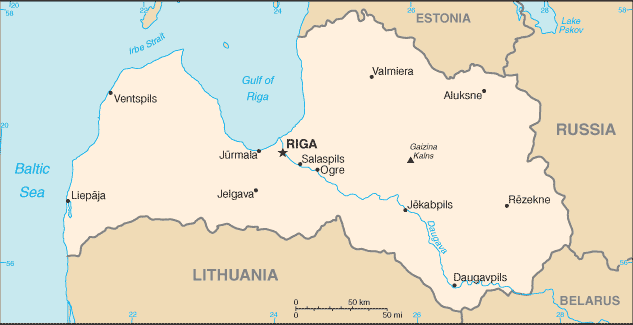Latvia
Related Categories:
 Flag of Latvia
Flag of LatviaThree horizontal bands of maroon (top), white (half-width), and maroon. |
 National Symbols of Latvia
National Symbols of LatviaBearing a red flag with a white stripe ancient Latvian tribes went to war against ancient Estonian tribes.
www.combinedendeavor.
The Latvian flag is reputed to date from 1279, which would make it one of the oldest national flags.
www.fotw.us/
The territory of Latvia has been populated since 9000 BC with the proto-Baltic ancestors of the Latvian people settling on the eastern coast of the Baltic Sea around the third millennium BC.
en.wikipedia.org/
The behavior of most Latvians reflects the strong cultural and religious influences of centuries-long Germanic and Scandinavian colonization and settlement. They are viewed as self-reliant, independent, persistent, and reserved. Eastern Latvia (Latgale), however, retains a strong Polish and Russian cultural and linguistic influence. This highly literate society places strong emphasis upon education, which is free and compulsory until age 16. Latvians are very tolerant of various religious denominations; in some cases, congregations from two or even three denominations make use of a single church. The majority of Latvians belong to the Evangelical Lutheran Church; a sizable minority is Russian Orthodox, and Eastern Latvia is predominantly Roman Catholic.
Historically, Latvia has always had fairly large Russian, Jewish, German, and Polish minorities, but postwar emigration, deportations, and Soviet Russification policies from 1939 to 1989 reduced the percentage of ethnic Latvians in Latvia from 73% to 52%. In an attempt to preserve the Latvian language and prevent ethnic Latvians from becoming a minority in their own country, Latvia enacted language, education, and citizenship laws which require capability in the Latvian language in order to become a citizen. Such legislation has caused concern among many non-citizen resident Russians, despite Latvian legal guarantees of universal human and civil rights regardless of citizenship.
Written with the Latin alphabet, Latvian is the language of the Latvian people and the official language of the country. It is an inflective language with several analytical forms, three dialects, and German syntactical influence. The oldest known examples of written Latvian are from a 1585 catechism. Latvians and Lithuanians are the only surviving direct descendents of the Baltic peoples who speak languages of the Indo-European family. While Latvia was a member of the U.S.S.R, Russian was the official language, so most Latvians also speak Russian, and the resident Slavic populace generally speaks Russian as a first language.
www.state.gov/r/
Introduction
About
Contact
Symbols in The News
Interpret this Symbol
AAC
African
AI
Alchemy
Alphabets
Ancient
Animal Symbolism
Architecture
Art
Articles
Astrology
Baha'i
Blissymbolics
Blueprint Symbols
Buddhist
Celtic Symbols
Cemetery
Chinese Symbols
Christian
Circle
City
Codes
Color
Conlangs
Crop Circles
Danger
Da Vinci Code
Designing Logos
Dictionaries
Dreams
Education
Egyptian Symbols
Electrical
Emoticons
Find Images
Fonts
Food
Fraternity
Hamsa
Healing
Heraldry
Hermetic
Highway Signs
Hindu
History
Hobo
Holiday
Icons
iConji
Islamic
Jain Symbols
Japanese, Kanji
Jewish
Justice
Law
Literary Symbolism
Mandalas
Map
Masonic
Math, Number
Meaning of Names
Medical
Middle East
Military
Miscellaneous
Money
Music
Mythology
Native American
Playing Cards
Power
Psychology
QiQiiKhu
Reiki
Religious
Runes, Norse
Sacred Geometry
Scientific
Science Fiction
Sorority
Sports
Symbols in the News
Tattoos
ThirteenSymbols
Tree of Life
Ursprache
Videos
Visual Languages
Weather
Web Codes
Wicca
Words
Writing Systems
Braille
Coinherence
Coptic
Cuneiform
Easter Island
Etruscan
Happy Human
Hebrew
Kokopelli
Linear B
Lotus
Love Symbols
Mandorla
Moon Alphabet
Nine Pointed Star
Om
Oz
Phonetic
Scarab Beetle
Silent
Theosophy
Unifon
About
Contact
Symbols in The News
Interpret this Symbol
AAC
African
AI
Alchemy
Alphabets
Ancient
Animal Symbolism
Architecture
Art
Articles
Astrology
Baha'i
Blissymbolics
Blueprint Symbols
Buddhist
Celtic Symbols
Cemetery
Chinese Symbols
Christian
Circle
City
Codes
Color
Conlangs
Crop Circles
Danger
Da Vinci Code
Designing Logos
Dictionaries
Dreams
Education
Egyptian Symbols
Electrical
Emoticons
Find Images
Fonts
Food
Fraternity
Hamsa
Healing
Heraldry
Hermetic
Highway Signs
Hindu
History
Hobo
Holiday
Icons
iConji
Islamic
Jain Symbols
Japanese, Kanji
Jewish
Justice
Law
Literary Symbolism
Mandalas
Map
Masonic
Math, Number
Meaning of Names
Medical
Middle East
Military
Miscellaneous
Money
Music
Mythology
Native American
Playing Cards
Power
Psychology
QiQiiKhu
Reiki
Religious
Runes, Norse
Sacred Geometry
Scientific
Science Fiction
Sorority
Sports
Symbols in the News
Tattoos
ThirteenSymbols
Tree of Life
Ursprache
Videos
Visual Languages
Weather
Web Codes
Wicca
Words
Writing Systems
Braille
Coinherence
Coptic
Cuneiform
Easter Island
Etruscan
Happy Human
Hebrew
Kokopelli
Linear B
Lotus
Love Symbols
Mandorla
Moon Alphabet
Nine Pointed Star
Om
Oz
Phonetic
Scarab Beetle
Silent
Theosophy
Unifon
